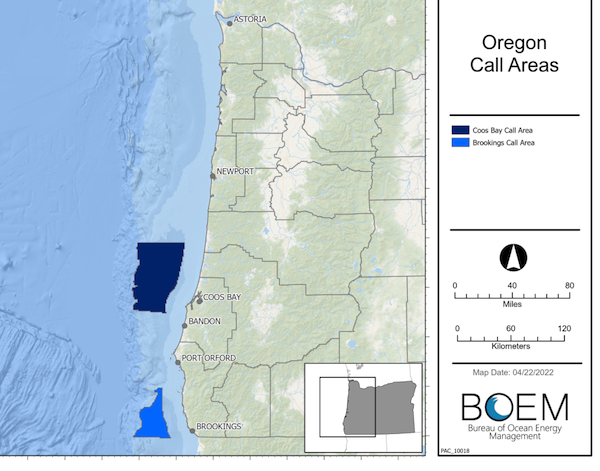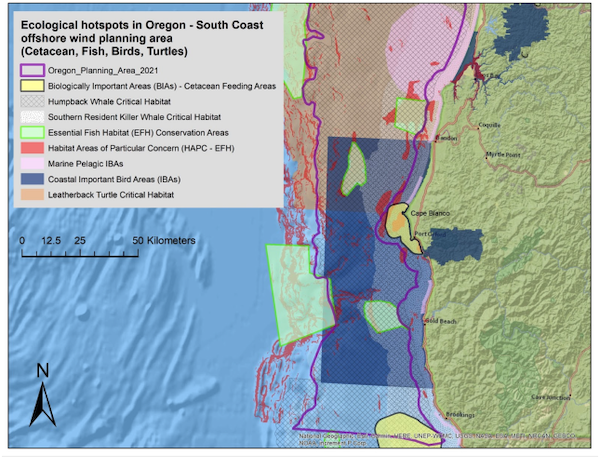
In April, the Bureau of Ocean Energy Management (BOEM) published a Call for Information and Nominations (Call) to assess commercial interest in, and obtain public input on, potential wind energy leasing activities in federal waters. Following several months of public engagement where Oregonians sounded off on the proposed areas and process for offshore development, BOEM has refined the final Call Areas and is now in the final week, set to end June 28th, 2022, of soliciting commercial interest for potential lease sales and the public's interest in those offshore areas. Surfrider Foundation is working with a coalition of environmental groups, local and state agencies, fishing interests and other key ocean stakeholders to provide extensive information and feedback (read our comments here) to BOEM by this month's deadline in an effort to minimize conflicts and negative impacts and maximize the benefits to Oregonians.
 Pictured above are the "Call Areas", locations where BOEM is seeking feedback and commercial development interest for offshore wind energy. The Call includes two areas located offshore the coast of Oregon identified as the Coos Bay Call Area and the Brookings Call Area. These two areas total about 1,159,298 acres (1,811 square miles) and are located offshore south-central and southern Oregon, respectively
Pictured above are the "Call Areas", locations where BOEM is seeking feedback and commercial development interest for offshore wind energy. The Call includes two areas located offshore the coast of Oregon identified as the Coos Bay Call Area and the Brookings Call Area. These two areas total about 1,159,298 acres (1,811 square miles) and are located offshore south-central and southern Oregon, respectively
Surfrider Foundation was extremely pleased to see the removal of the Bandon Call Area, proposed in the draft Call Areas process that overlapped with a culturally and ecologically significant habitat as well as a Stewardship Area adopted by the community of Port Orford. Surfrider Foundation and the Port of Port Orford both provided extensive comments of concern about this area during the draft call. The other two Call Areas that remain, Coos Bay and Brookings, have elicited the most vocal response from the commercial fishing industry, particularly the MidWater Trawlers that carry concerns with important overlapping fishing grounds. Similarly, Oregon's conservation community has identified data gaps for important species and strong concerns with overlapping ecologically significant areas such as the southern portion of Heceta Bank and important bird and whale migration corridors along the eastern portions of both the Coos and Brookings Call Areas.
 Oregon's southern coast is extremely rocky and full of productive rich habitat for many species that serve a multitude of ecosystem services. Map Credit: Ben Enticknap, Oceana
Oregon's southern coast is extremely rocky and full of productive rich habitat for many species that serve a multitude of ecosystem services. Map Credit: Ben Enticknap, Oceana
Following a month of field trips up and down the Oregon Coast, Oregon's coastal delegation of state legislators (Coastal Caucus) have also responded to BOEM's call with extensive public engagement and some clear asks that you can read here - Coastal Caucus Letter - Offshore Wind 06-03-22.
At the federal level, Congressman DeFazio, representing the district adjacent where offshore wind is most likely to be developed, has penned a similar letter with Congressman Wyden - Defazio Wyden Letter to BOEM on Oregon Call Areas. Some general themes across Oregon ask BOEM for: Performing a programmatic EIS, moving Call Areas further out beyond 1300m to reduce user and wildlife/ecosystem conflicts, to revise the BOEM Oregon renewable energy task force to include non-governmental stakeholders, and to ensure federal partners (like NOAA!) have full input at every step.
Surfrider Foundation is finalizing comments this week in response to BOEM's official Call - working with a coalition of environmental groups, ocean users, and our federal delegates to best respond to Oregonians interest in offshore wind development. Surfrider Foundation's work with the coalition has been to focus on many of the concerns of recreational and shoreside users, some of which we've outlined here during BOEM's draft Call. We spent the early phases of the call this year educating our members on the process and both developer and ocean user interests and concerns - watch our webinar here. We've met with ocean recreational and shoreside users, fishing community, industry developers, elected officials, local and state fisheries managers and believe that any path forward is going to take trust and collaboration that engages all parties at the ground level - which is exactly what our national Surfrider Foundation Renewable Ocean Energy Policy calls for.
Want to engage in BOEM's Call process? Here's how to get involved and what they are looking for:
In addition to commercial interest, BOEM is seeking information regarding site conditions, resources, and multiple uses in close proximity to or within the Call Areas. The Call Areas are of a sufficient size to allow for refinement. BOEM, in coordination with the State, is considering 3 gigawatts for near-team commercial development for the first leasing activities offshore Oregon, less than one-fourth of the estimated 14 gigawatts of potential capacity within both Call Areas. BOEM will use information and feedback resulting from this Call to inform the delineation of Wind Energy Areas for environmental reviews for potential offshore wind leasing.
Publication of the Call in the Federal Register will initiate a 60-day public comment period ending at 8:59 p.m. PT on Tuesday, June 28, 2022. The Oregon Offshore Wind Mapping Tool (OROWindMap) is a planning tool that can be used to supplement the narrative part of your public comment if you would like to include a map to highlight specific data layers or to create and share map annotations (drawings). Instructions are available here.
You can add your comments online at https://www.regulations.gov/search?filter=boem-2022-0009. You can also comment in writing by mail. Send to Dr. Whitney Hauer, Renewable Energy Specialist, Bureau of Ocean Energy Management, Office of Strategic Resources, 760 Paseo Camarillo (Suite 102), Camarillo, California 93010.
Some common themes and ideas for talking points for comments from Surfrider's Oregon members and partners:
- These floating offshore wind turbines will be located in the midst of the California Current Large Marine Ecosystem, one of the planet’s most productive marine areas, the habitat of abundant wildlife which could be impacted by industrial development in the ocean. Full studies of potential conflicts with wildlife should be conducted before this process goes forward, including more research on whether large numbers of turbines could damp down winds and reduce the wind-caused nutrient upwelling that drives the productivity of these areas.
- There are six proposed "Call Areas" for offshore wind development on the U.S. West Coast, all of which are within the California Current ecosystem. The cumulative impacts of development in all these areas considered together should be studied and a programmatic Environmental Impact Statement (PEIS) should be done for the entire west coast before any decisions are made.
- Call Areas should be modified to minimize wildlife impacts. Sections on the eastern side of these areas as currently drawn are hot spots for marine mammals, bird species, and turtles; shaving about 15 kilometres off the east side of the call areas would alleviate the worst impacts. Likewise, the northern portion of the Coos Bay call area overlaps with the Heceta Bank, one of the most productive areas for wildlife on the entire West Coast. Consideration should be given to eliminating these sections from the Call Areas and perhaps moving the them farther offshore in deeper waters, where there would be fewer conflicts with wildlife.
- If thorough studies indicate that the harm to these important wildlife areas outweighs the benefits of wind energy production, halting the offshore wind energy development process should be accepted as a possible outcome.
- The process should be allow for greater stakeholder inclusion and ensure impact studies are completed and data gaps are filled, rather than rushing to create momentum toward development by designating the Call Areas and beginning to issue leases to would-be developers.
- Full consideration should be given to onshore impacts of wind development, including cables crossing the nearshore ocean and beach, new high-voltage electricity transmission infrastructure, and construction of facilities in estuaries for building and servicing wind turbines. Possible conflicts with Oregon’s land use planning and other laws should be thoroughly considered in advance.
- Modeling full buildout of physical ocean and atmospheric impacts to nearshore resources.
- If offshore wind energy facilities are developed off our shores, there will inevitably be some degree of impact to wildlife. A mitigation plan to offset such damage with improvements in other locations must be in place before the project proceeds.
Additionally, Rogue Climate is hosting a workshop on Tuesday, June 21, from 6:00PM-7:30PM, for a virtual “Floating Offshore Wind Comment Writing Workshop” to learn background information on floating offshore wind and how to submit your feedback in comments to BOEM. Sign up to join the workshop at: bit.ly/FOSWWORKSHOP2022
